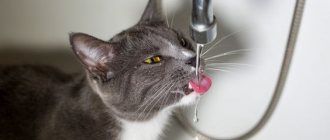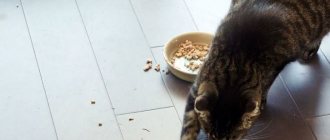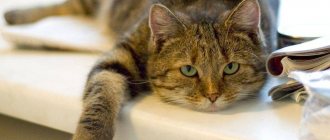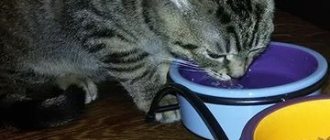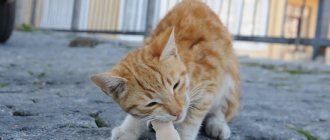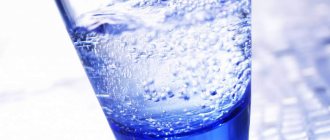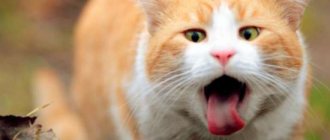As soon as the long-awaited kitten is at home, the owner has many problems and questions. In addition to the eternal ones - what to feed and where will he go to the toilet, another one arises: why doesn’t the kitten drink water, but at the same time eats well? In our article we will try to figure out in which cases this issue may cause concern and in which it does not.
What water to give a kitten
The smell and taste of water seem incomprehensible and strange to the kitten, because they do not resemble mother’s milk.
A small cat does not need to explain the need for moisture for the body, so teaching it to lap from a bowl is not difficult
This causes difficulty in bowl training small cats. But moisture plays an important role in the growth of the pet’s body, so you need to be careful when choosing it. A high-quality drink will help the kitten quickly get used to lapping from dishes.
Attention! Boiled water is not healthy for animals.
Tap water may contain chlorine, which can repel and harm animals. Boiling will not help get rid of harmful compounds; it will increase their concentration. Due to poor quality liquid, a small cat will not be able to get mineral elements. Your pet will be at risk of developing urolithiasis.
Bottled or filtered tap water contains the necessary elements to support metabolic processes . It is already ready for consumption and does not need to be cleaned.
Which liquid is most useful?
The health of a cat depends not only on the amount of fluid, but also on its quality. Before worrying about the amount of water absorption, you need to think about the best liquid to take for your pet.
Types of water:
- Boiled;
- Distilled;
- Raw type;
- Tap type;
- Bottled.
Boiled liquid has the least number of useful substances. Scientists consider such a liquid to be dead, and after several hours after boiling it becomes dangerous due to the attraction of microbes that are nearby.
Experts do not recommend giving your pet boiled liquid not only for this reason, it can lead to the progression of urolithiasis. Distilled water also has almost no benefit.
Tap liquid is endowed with various chloride compounds, bacteria, organisms, salts, and so on. The general composition of tap fluid is not needed by a cat’s body, especially at an early age.
Raw liquid from a spring or well is considered useful, but at the same time it may contain many unnecessary substances.
Bottled liquid is considered the most useless option, but it must be of high quality. It is better to give your pet water from a bottle, which is obtained from underground sources. Such water is most often expensive and not every owner buys it.
How to teach a kitten to drink water from a bowl or jar
Many owners don’t know how to teach a kitten to drink water from a bowl; they try to poke it with its muzzle into the container , but this scares the pet. Use tall, dark dishes that won't confuse your cat with bright colors.
Bottled or filtered tap water contains the necessary elements to support metabolic processes
Try to entice them with a game: sprinkle a few drops with your fingers or a spray bottle. The kitten will become interested in splashing water, water circles in a bowl, and out of curiosity wets its paw into the container.
Be sure to read:
How to discourage cats from being tagged: what to do, folk and special remedies
This may frighten him, but try to reassure your baby that the liquid in the bowl is safe. Repeat the above methods, then he will get used to the bowl.
Attention! If the kitten is vomiting severely, you will have to force liquid into it using a syringe to prevent dehydration.
Another option will also help accustom your cat to the bowl: use catnip. Place the container on a cloth soaked in the liquid extract, and the cat will not remain indifferent to its smell. Try not to overdo it with mint: animals' sense of smell is much more subtle than human perception of odors.
The easiest way is to arrange dishes of different shapes and observe which bowl the kitten pays more attention to. Most importantly, don't stand next to him and don't force him to drink. Your presence can distract the cat or frighten it.
Important! Often cats drink water from the shower or sink because they are interested in it.
British fold blue whiskey color
I never tire of admiring the richness and flexibility of the Russian language, in which new verbal formations periodically arise, completely crazy in essence, but absolutely understandable in meaning to most people. Cats have not been left out either, and a striking example of this is the stable phrases British fold cat, British blue kitten and Whiskas cat. So who are they?
British fold
In fact, there are two separate breeds - the British Shorthair and the Scottish Fold. Unlike the British breed, the Scottish Fold appeared much later and the specifics of its breeding are such that a partner with a normal ear shape must be selected to pair with the Fold. Initially, the breed arose from the British, and although several breeds took part in the formation of the modern appearance of the Scottish Fold, in Russia matings with the British were widespread, especially until 2004, when in the most extensive felinological system of the WCF, all straight-eared kittens from such marriages were registered as British people with BRI coding, although their genetics were different. This is difficult to understand for a person inexperienced in matters of breeding, especially considering that due to the numerous connections of the British breed to the Scottish Folds, many animals of an intermediate type and straights and folds of the British type appeared. That is why this strange phrase arose as “British Fold” in conjunction with the British Straight Ear, apparently, since in appearance they were practically no different, only in the shape of the ears. (The photo on the right shows littermate kittens born in 1997, registered as Scottish Fold and British).
| Schematic representation of a typical British and typical Scottish Fold head |
| When comparing, it is clearly visible that the British have fuller cheeks; the shape of the fold's ear pads for the British would be pinched. In profile, you can see that the Fold has a round head set higher on the neck, while the British has a rounded head set low on the neck, which creates the impression of a powerful scruff. The fold profile for a Briton would be too extreme; according to the standard, the transition from forehead to nose is smooth, outlined but without a stop (sharp transition). The Scottish Straight has higher and straighter ears, with the auricle facing forward. |
| Comparison of the British and Scottish Fold physiques |
| The Briton has a large heavy body, on short powerful limbs, a short thick tail, rounded at the end. In height from the withers to the floor, the body occupies 2/3 and the legs 1/3. The Scottish Fold has a lighter constitution, longer limbs and a long, tapering tail. In height from the withers to the floor, the body and legs occupy 1/2 each. |
British blue
Another essentially incorrect phrase. Yes, the blue color is the most common and recognizable in the British breed, at least among ordinary people, but it also recognizes all colors existing in nature, and the breed is called the British Shorthair, not the British Blue. In contrast to the “Russian Blue” breed, which really exists in a single color variation, blue, which is included in the name of the breed.
|
|
Whiskas color or whiskey color
There is no such color! No whiskey, no whiskey. Whiskas is a company that produces products and food for cats, which has chosen British cats of the silver-black patterned color group as advertising for its products. And these are at least three different colors - spotted, brindle and marbled. In the photo on the left, the kittens are not “whiskey”, but black silver spotted (BRI ns 24) and black silver marbled (BRI ns 22) colors!
Why does a kitten not drink water well?
A kitten's refusal to drink may indicate that its teeth are changing. This occurs when the animal reaches 3-5 months. The kitten tries not to touch the loose tooth, so it is difficult for him to lap up liquids. Severe pain can cause your pet to eat less of any food. It is better to teach a kitten to drink water before the age of 3 months.
When kittens begin teething, they experience severe itching in their gums and chew on objects. If something gets stuck in a cat's throat, he will not be able to swallow normally and will refuse to drink. Try not to leave small objects on the floor - kittens will definitely try them.
Attention! Wet food already contains a certain amount of water, so the kitten may drink less if it eats spiders.
When is there no reason to worry?
A very small kitten has not yet transitioned to an adult lifestyle, and therefore receives all the necessary substances from the milk of its mother cat. Milk is both food and drink for the baby, so very young animals should not be persistently given water.
There is also no reason to worry if the animal eats a lot of natural food containing moisture. Such suitable foods include dairy products, eggs, buckwheat and other cereals. If your pet eats canned food, then it can also get enough water from it.
What kind of water is best to give to a cat?
Tap water is the simplest and most harmless option. But it must be cleaned before being consumed. Many owners of aqua filters forget that the device needs to be constantly changed.
Be sure to read:
A cat shits anywhere: reasons and what to do
Tap water is the simplest and most harmless option.
Filters wear out and stop doing their job. To clean the liquid from harmful substances, you can leave it in a tightly closed container for 6-8 hours. Running water contains a lot of oxygen; it attracts pets more than bottled or boiled water. This is why many cats love to climb into aquariums: they are always equipped with devices that saturate the water with oxygen.
Drinking fountains are an expensive pleasure, but this device is the most convenient and better purifies the liquid from harmful impurities. The liquid in such devices constantly circulates, enriched with oxygen and cleansed of harmful impurities. Some drinkers have a dome with a hole at the top.
It will be convenient for your pet to lick the dripping liquid. Veterinarians say that using a drinking fountain can quickly teach a cat to drink water.
Many owners, trying to please their pet, aggravate its condition. Boiling rids the liquid of parasites and the smell of chlorine. But when it evaporates, the concentration of salts increases. The resulting sediment mixes with the water and makes it “heavy.” Such drinking will not benefit the animal.
If you are concerned about the health of your family and pets, it is easier to buy bottled water. It's more expensive than pouring it from the tap. But bottled water reaches customers completely purified from harmful substances and parasites.
By looking at reviews, you can be convinced of the quality of a product of a particular brand. You cannot always be sure that the filters are working properly; they need to be constantly changed. Buying bottled water can be even more cost-effective than constantly changing purification devices.
How about fish?
3. Cats should not be given fish often.
Kittens can be given fish once a week, and adult cats no more than once every two weeks, but it is better to exclude it altogether from the diet of an adult cat. Give the fish boiled and without bones. In case of urolithiasis and other diseases of the urinary system, especially in castrated cats, exclude fish from the diet forever. 4. Mixing natural food and dry food is strictly forbidden. And if you feed a British cat with dry food, then adding natural food (meat, fish, vegetables) to the diet is also prohibited, as this can lead to diseases of the gastrointestinal tract and urinary system in the future.
To digest dry food and natural products in the cat's intestines, different enzymes and a completely opposite acidic environment are required. When these two completely opposite types of feeding are mixed, an imbalance occurs in the cat's stomach, and the liver suffers greatly from this double load. The cat’s intestines react differently and digest dry food and natural food, and simply do not have time to switch from one type of feeding to another, and this is fraught with a bunch of diseases in the future.
In general, the opinions of veterinarians and breeders differ on this matter, and they themselves feed their cats meat and porridge in the morning, and leave dry food in a bowl for the day. But “the facts are clear” and I will not feed my animal according to this scheme.
How to determine if your cat drinks enough fluid per day
Animals have the same problems as humans when they don't get enough fluids. Cats may not get the moisture they need for a variety of reasons, but owners should closely monitor their pet's health.
Be sure to read:
What to do if a cat marks in the apartment, how to deal with it
The following signs may indicate your pet's condition:
- Skin elasticity . Your pet's skin becomes dry and stiff if he doesn't drink enough fluids. Normal dermis quickly regains its shape if you grab the cat's scruff and pull.
- Condition of the coat. It is worth sounding the alarm when the cat’s fur loses its shine and begins to fall out. If the animal does not have parasites or allergies to the selected diet, then the problem may lie precisely in the lack of moisture. When a pet's coat is shiny, it makes it clear that its health is not in danger.
- Physical activity. Without the necessary moisture, the cat becomes inactive, reacts sluggishly to calls, and does not want to play.
- Frequency of urination . If an animal urinates less than 2 times a day, this is a sign of ill health.
How much should a kitten drink depending on its age?
A baby up to 1 month of age needs only breast milk. The cat is 4-6 weeks old and the cat begins weaning it. He gradually switches to soft food, then to solid food. There is a need for additional sources of fluid.
The amount of water consumed depends on the weight of the kitten.
Table: norm of water consumption for a kitten depending on age and weight
| A kitten’s daily water consumption rate is calculated using the formula: m (g) x 0.03 = V (ml), where m is the kitten’s weight in grams, V is the volume of water required | ||
| Kitten age (months) | Average weight (g) | Required amount of water (ml) |
| 1 | 200–500 | 6–15 |
| 2 | 700–1300 | 21–39 |
| 3 | 1200–1700 | 36–51 |
| 4 | 1800–2200 | 54–66 |
| 5 | 2300–3500 | 69–105 |
| 6 | 2500–4000 | 75–120 |
| 7 | 2800–4200 | 84–126 |
| 8 | 3000–4500 | 90–135 |
| 9 | 3300–5000 | 99–150 |
| 10 | 3500–5500 | 105–165 |
| 11 | 3700–5800 | 111–174 |
| 12 | 3900–6000 | 117–180 |
Harm from a lack of fluid in a kitten’s body
The owners are worried that the pet doesn’t drink enough. The concern is justified. An insufficient amount of water in a kitten’s body can affect its health:
- there is a high probability of formation of kidney stones;
- dehydration worsens the condition and appearance of the animal;
- insufficient water consumption leads to problems with the coat;
- the mustache falls out or becomes brittle;
- lymph thickens, which leads to disruption of the water-salt balance.
Eating dry food can aggravate dehydration. Lack of water causes inhibition of the animal's mental and physical development.
When feeding dry food, water is vital for animals
The cause of concern may be unfounded if the animal eats natural food that is rich in moisture. Food products suitable for a kitten include dairy products, cereals and eggs. Canned wet food is added here. They contain a sufficient amount of moisture. But if the kitten categorically does not approach the water, the problem cannot be left to chance.
What determines the frequency of water consumption in a healthy kitten?
The following factors influence the number of water intakes:
- moisture content in the animal's diet;
- ambient temperature conditions.
Kittens that eat canned and natural food drink less. Babies whose diet consists of dry food experience a lack of fluid in the body. Accordingly, they need an additional source of moisture.
A kitten's drinking behavior depends on environmental factors. If the weather is dry and hot, the amount of water consumption may increase several times. In cool weather, the animal can drink very little.
The kitten drinks not only during the daytime, but throughout the day. Therefore, it is important to provide him with unhindered access to water.
How to tell if your kitten has enough water
Appearance helps determine whether an animal has enough water. Dehydration is noticeable to the naked eye:
- sunken eyes;
- lethargy, shortness of breath;
- refusal to eat;
- the kitten does not go to the toilet (the norm is 3-4 bowel movements per urination process daily);
- dull coat;
- skin peeling.
To understand whether the animal is experiencing a lack of fluid, it is enough to observe the kitten for some time. A dehydrated animal loses its skin elasticity.
To check whether the kitten is suffering from dehydration, pull back the skin on the withers (this is where the mother cat usually carries her babies) and release. If everything is in order with elasticity, then the pulled skin on the nape will quickly take its natural shape.
Pull back the kitten's scruff to check if he is lacking fluids.
In addition, the coat should form a single coat, without bald patches. There should be no peeling of the epithelium. A healthy baby is always cheerful and curious.
Reasons why a kitten does not eat food
Let's figure out why the kitten doesn't eat anything? What made the baby starve?
Stress
No matter how proud cats are, they are very sensitive. It would seem, what’s wrong with moving or a change of scenery? But such little things can affect the psychological state of the animal. The animal needs a couple of days to adapt to the changed conditions. If possible, eliminate all possible sources of stress and provide your baby with peace. Let fresh water and some food be within his sight, but away from people. Perhaps the kitten needs a calm environment and privacy.
Too young
Some people buy kittens that are too small. Unscrupulous breeders are trying to “fuse” kittens as quickly as possible so that the cat goes into heat faster and gets offspring from her again. As a result, kittens do not yet know how to eat on their own. Hence the hunger strike.
The baby would be happy to eat a hearty meal, but he can’t, he doesn’t know how. To prevent the baby from starving to death, you will have to purchase a special cat's milk substitute (it costs a lot, but is ideal for kittens) and a bottle. Cow's or goat's milk are not suitable because the kitten's intestines cannot digest such fatty milk.
Environment
Cats are very clean (with rare exceptions), so they are uncomfortable with the fact that their feeding area looks untidy or dirty. The animal will endure to the last, but will not touch even its favorite food if the bowl is poorly washed or there is a lot of garbage around the feeding area.
Strong odor from food or bowl
Some bowls made of polymers, especially in the first days of their use, have a strong, unpleasant odor. Cats have a keen sense of smell. And such a “bright” chemical smell will repel the pet from food. In addition, food can smell like plastic and have an unpleasant aftertaste. But even if the bowl (in your opinion) no longer smells, the detergents you use to clean your cat's bowl may have a strong odor. do not forget that they also have a fairly diverse chemical composition. Still, it is better not to use chemicals when washing dishes for feeding an animal. If you want to kill the infection, then simply pour boiling water over the bowl (if the manufacturer and material of the dishes allow this).
Helminths
Some types of parasites, on the contrary, awaken a brutal appetite in the baby. But still, in most cases, the tiny organism is not able to fight helminths. All the forces of the immune system are spent exclusively on the fight. Therefore, there is absolutely no money left for food consumption. Modern veterinary drugs can be given to tiny kittens. Some anthelmintics can be given just once, but it is usually recommended to repeat the procedure after 10-14 days.
This is due to the fact that during this time those parasites that were not affected by the first dose reach a different stage of development. And now on it they become sensitive to the active ingredient of the anthelmintic. Be sure to carry out 2 procedures for expelling parasites, even if you do not find any worms in the kitten’s feces or vomit. Perhaps his body contains just the larval stage, which is covered with a dense shell that does not allow the drug to kill the helminth.
Infectious diseases
The little kitten does not eat because an infection has raged in its body. At least remember yourself during the flu. Do you eat a lot? And a baby, especially if he is too early or has just been torn away from his mother, can have a huge number of life-threatening diseases. Any infection clings to his fragile body. The immune system is not yet very developed
That is why it is so important to carry out preventive vaccinations according to age on time. This can save the purr from a lot of problems.
